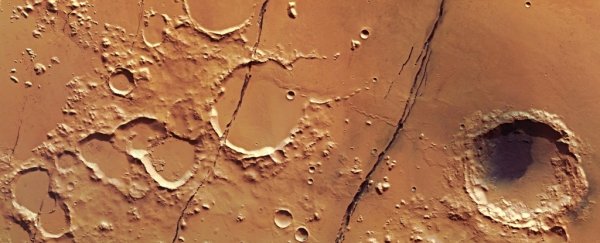Although we're yet to detect any sort of life on Mars, the planet is not a quiet one. Deep in its guts, the Red Planet rumbles - the seismic stirrings of a geologically active chunk of rock.
The first slew of data from NASA's Mars InSight lander is in, and the results have given us the first direct evidence of marsquakes. This puts the planet's profile of seismic activity somewhere between Earth's (high) and the Moon's (low).
A series of papers detailing the new results from InSight have just appeared in a special issue of Nature.
"This is the first mission focused on taking direct geophysical measurements of any planet besides Earth, and it's given us our first real understanding of Mars' interior structure and geological processes," said geologist Nicholas Schmerr of the University of Maryland.
"These data are helping us understand how the planet works, its rate of seismicity, how active it is and where it's active."
InSight - a lander destined to teach us more about what's inside Mars - felt its first tremors in April of last year with its Seismic Experiment for Interior Structure (SEIS) instrument.
These tremors, if they're strong enough, can act a bit like a planet-sized ground-penetrating radar, only with seismic waves instead of electromagnetic. As these waves propagate through a planet, they can slow down as they move through certain materials, or bounce off others, letting seismologists infer the interior composition.
And the type of tremor can reveal clues, too. For instance, much of Earth's seismic activity is produced by the moving tectonic plates of the planet's crust. The Moon, however, has no tectonic plates; its seismic activity is caused by the slow and slight shrinking that occurs as our satellite cools, a process that has been ongoing since it formed 4.5 billion years ago.
Back on Mars, that first tremor wasn't strong enough to gauge much. But over 235 Martian days, the instrument recorded 174 marsquakes. Of these, 150 were high-frequency tremors like those recorded by Apollo experiments on the Moon.
The remaining 24, however, were low-frequency quakes. This is really interesting, because although planetary geologists believe Mars was tectonically active once upon a time, it's generally thought that the planet is pretty quiet now.
"The other 24 have dominantly low-frequency content, and their spectral shapes follow the same scaling laws as earthquakes and moonquakes, leading us to conclude that they are of tectonic origin," wrote a team of scientists in a paper summing up the results.
"The characteristics of these spectra are compatible with expectations for distant tectonic events."
In addition, the way the waves propagate through the crust can be used to trace the quakes to a source. Three of the 24 Earth-like quakes were strong enough for this to be attempted.
The team was able to trace two of those three quakes to the Cerberus Fossae region, where a series of fissures can be found, created by faults that pulled the crust apart. Evidence suggests it was tectonically and volcanically active recently, i.e., within the last 10 million years (hey, that's recent for rocks).
A second paper based on the data from SEIS looked for something different - the interior composition of Mars. They found that a layer of regolith down to a few metres, and beyond that, the crust of Mars, to a depth of between 8 and 11 kilometres (5 to 7 miles), is highly altered or damaged.
And the way the waves are stretched out in the crust suggests that it contains small amounts of volatiles - more than the Moon, but less than Earth.
But there's even more. InSight isn't just equipped with seismic instruments, it's also measuring the atmosphere and the surrounding geology of its landing site.
We know, thanks to orbiters, that atmospheric gravity waves - ripples in a fluid medium, such as gases and liquids - can occur on Mars. In a paper on the Martian atmosphere, InSight has provided a catalogue of the different kinds of such waves in the Martian atmosphere.
And they discovered infrasound in the Martian atmosphere, too.
"From these measurements, we have discovered Martian infrasound and unexpected similarities between atmospheric turbulence on Earth and Mars," the researchers wrote. "We suggest that the observations of Mars's atmosphere by InSight will be key for prediction capabilities and future exploration."
In yet another paper, a team of researchers studied the planet's magnetic field at the InSight landing site. It's been established that Mars has a pretty weak magnetic field, which is thought to contribute to its inhospitable nature.
Their results suggest that Mars wasn't always this way.
"We find that the field is ten times stronger than predicted by satellite-based models," the researchers wrote. "We infer magnetised rocks beneath the surface, within ~150 km of the landing site, consistent with a past dynamo with Earth-like strength."
All together, the results are adding to the pile of evidence that suggests Mars was once a very different place. And, of course, they could help inform crewed missions to the planet - not just telling us what to expect, but where to look to find more clues to Mars' secrets.
Meanwhile, the InSight mission is scheduled to continue for another Earth year… so we should be finding out more about what's hiding underneath that enigmatic red surface.
The papers have been published in a special issue of Nature. You can find them here, here, here, here, here and here.
